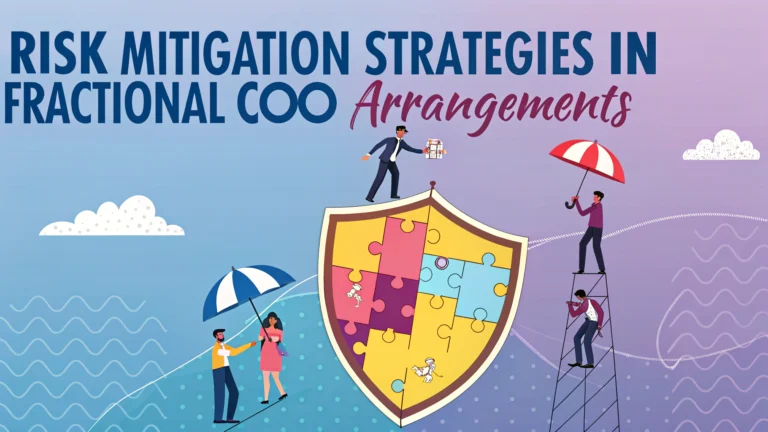Risk management is a fundamental aspect of fractional COO arrangements that requires careful planning and strategic implementation.
Organizations leveraging fractional leadership must establish clear protocols to protect both the company and the interim executive while maintaining operational efficiency.
This guide outlines practical strategies to minimize risks and maximize the effectiveness of fractional COO partnerships.
Key Risk Areas in Fractional COO Arrangements
- Data security and confidentiality breaches
- Intellectual property protection
- Operational continuity gaps
- Knowledge transfer challenges
- Performance measurement uncertainty
Contractual Protection Measures
A well-structured Service Level Agreement (SLA) should outline specific deliverables, timelines, and performance metrics.
Non-disclosure agreements (NDAs) must be comprehensive and include digital asset protection clauses.
Clear termination clauses should specify notice periods, transition requirements, and post-engagement obligations.
Data Security Protocols
- Implement secure access protocols with multi-factor authentication
- Use encrypted communication channels for sensitive information
- Establish document sharing and storage guidelines
- Create audit trails for data access and modifications
Operational Continuity Planning
Document all processes and procedures in a centralized knowledge base accessible to key stakeholders.
Create detailed handover protocols for smooth transitions between fractional and permanent staff.
Establish backup systems and redundancy measures for critical operations.
Performance Monitoring Framework
| Metric Category | Key Performance Indicators |
|---|---|
| Operational Efficiency | Process improvement rates, cost reduction |
| Project Delivery | Completion times, milestone achievement |
| Team Development | Staff productivity, skill enhancement |
Communication Standards
- Schedule regular status updates and progress reviews
- Define escalation paths for urgent issues
- Maintain detailed documentation of all key decisions
- Create clear reporting structures and expectations
Insurance and Liability Coverage
Professional liability insurance should cover both the fractional COO and the organization.
Cyber insurance policies must address remote work arrangements and digital asset protection.
Employment practices liability insurance should extend to temporary executive positions.
Building Long-term Success
Regular risk assessments help identify and address potential issues before they escalate.
Investing in proper risk mitigation tools and protocols ultimately saves time and resources.
Contact your legal advisor at [email protected] for specific guidance on implementing these strategies in your organization.
Transition Management
- Create detailed knowledge transfer schedules
- Implement phased handover processes
- Document critical relationships and contacts
- Establish mentoring programs for internal staff
Technology Integration
Cloud-based collaboration tools should be properly configured with appropriate security settings.
Project management software must be standardized across all stakeholders.
Integration protocols should address both legacy systems and new technologies.
Essential Technology Components
- Virtual private networks (VPNs)
- Secure file sharing platforms
- Time tracking and project management tools
- Communication and collaboration software
Quality Assurance Measures
Implement regular audits of operational processes and documentation.
Establish peer review systems for major decisions and changes.
Create feedback loops for continuous improvement.
Crisis Management Protocol
- Define emergency response procedures
- Create backup leadership chains
- Establish communication protocols for critical situations
- Document disaster recovery plans
Securing Future Operations
Risk management in fractional COO arrangements requires ongoing attention and adaptation to changing business environments.
Organizations must balance flexibility with security to maintain operational effectiveness while protecting critical assets.
Success depends on establishing robust systems that can evolve with organizational needs while maintaining consistent risk management standards.
For additional support and resources, contact our risk management team at [email protected].
FAQs
- What are the key risks associated with hiring a fractional COO?
The main risks include potential confidentiality breaches, inconsistent availability, divided attention across multiple clients, cultural fit challenges, and knowledge transfer gaps when the engagement ends. - How can companies protect sensitive information when working with a fractional COO?
Companies should implement robust NDAs, establish clear data access protocols, use secure communication channels, maintain detailed documentation of shared information, and create specific confidentiality agreements for trade secrets. - What metrics should be tracked to ensure a fractional COO arrangement is successful?
Key metrics include project milestone completion rates, ROI on implemented initiatives, team satisfaction scores, operational efficiency improvements, cost reduction achievements, and specific KPIs aligned with organizational goals. - How should companies structure the contract with a fractional COO to minimize risk?
Contracts should include clear scope of work, deliverables, performance metrics, termination clauses, intellectual property rights, non-compete provisions, and specific time commitment expectations. - What backup plans should be in place if the fractional COO arrangement doesn’t work out?
Companies should maintain detailed documentation of processes, establish knowledge transfer protocols, have secondary leadership ready to step in, and create contingency plans for critical projects. - How can companies ensure consistent communication with a part-time executive?
Implement structured communication schedules, use project management tools, establish regular check-ins, define emergency protocols, and create clear escalation procedures for urgent matters. - What insurance and liability considerations should be addressed with fractional COOs?
Professional liability insurance, errors and omissions coverage, cybersecurity insurance, and clear indemnification clauses should be established to protect both parties. - How can companies maintain team alignment with a part-time leadership role?
Regular team meetings, clear communication channels, documented decision-making processes, defined reporting structures, and regular stakeholder updates should be established to maintain alignment. - What transition planning should be included in fractional COO arrangements?
Comprehensive knowledge transfer plans, documentation requirements, succession planning, handover procedures, and post-engagement support terms should be clearly defined. - How should intellectual property rights be handled in fractional COO agreements?
Clear IP ownership clauses, documentation of pre-existing IP, assignment of new IP created during engagement, and confidentiality provisions for proprietary information should be established.







